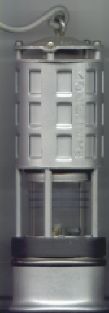John Scott Haldane
This article needs additional citations for verification. (July 2019) |
John Scott Haldane FRS | |
|---|---|
Friedrich Schiller University of Jena | |
| Known for | Black Veil Respirator Haldane effect Haldane's decompression model |
| Spouse | Louisa Kathleen Coutts Trotter |
| Children | J. B. S. Haldane, Naomi Mitchison |
| Awards | Fellow of the Royal Society, member of the Royal College of Physicians and of the Royal Society of Medicine; many honorary degrees |
| Scientific career | |
| Fields | Physiology, medicine |
| Institutions | University of Glasgow New College, Oxford University of Birmingham |
John Scott Haldane
Haldane visited the scenes of many mining disasters and investigated their causes.[2][5] When the Germans used poison gas in World War I, Haldane went to the front at the request of Lord Kitchener and attempted to identify the gases being used. One outcome of this was his invention of a respirator, known as the black veil.[2][6][4]
Haldane's investigations into
Background and family
Haldane was born in
Education
Haldane attended
On 12 December 1891 he married Louisa Kathleen Coutts Trotter (1863–1961),[7] daughter of Coutts Trotter FRGS and Harriet Augusta Keatinge.[8] They had two children: the scientist J. B. S. Haldane and the author Naomi Mitchison. His nephew was the New Zealand doctor and public health administrator Robert Haldane Makgill.[9]
Haldane also published his philosophical ideas about the true significance of biology.[4]
Career
Haldane was Gifford Lecturer in the University of Glasgow, Fellow of New College, Oxford, from October 1901,[10] and Honorary Professor of the University of Birmingham. Haldane received numerous honorary degrees. He was also President of the English Institution of Mining Engineers, a Member of the Order of the Companions of Honour, a Fellow of the Royal Society,[11] a member of the Royal College of Physicians and of the Royal Society of Medicine.
Haldane became a Fellow of the Royal Society in 1897, was a Royal Medallist of the Society in 1916, was appointed Member of the Order of the Companions of Honour in 1928 for work on industrial disease, and was a Copley Medallist in 1934.[4]
Death
Haldane died in
Sir Henry Newbolt wrote a poem called "For J. S. Haldane", published in his anthology A Perpetual Memory and other Poems in 1939.
Accomplishments
Respiration and anaesthesia
Haldane was an international authority on ether and respiration and the inventor of the Black Veil Respirator, an early gas mask, during World War I.[2][12]
He was also an authority on the effects of
Haldane helped determine the regulation of breathing, and discovered the
Haldane was the founder of The Journal of Hygiene.[citation needed]
Diving physiology
In 1907 Haldane had a
The mathematical model on which these tables were based, though considerably revised and modified, remains a widely accepted method of decompressing divers from non-saturation exposures. In 1908, Haldane published the findings with A. E. Boycott and G. C. C. Damant in the paper "Prevention of Compressed-Air Illness" in the
Coal and other mining incidents

He investigated the principle of action of many different gases. He investigated numerous
In the late 1890s, Haldane introduced the use of small animals for miners to detect dangerous levels of carbon monoxide underground, either white mice or canaries. With a faster metabolism, they showed the effects of poisoning before gas levels became critical for the workers, and so gave an early warning of the problem.
Pike's Peak expedition

Haldane pioneered the study of the reaction of the body to low air pressures, such as that experienced at high altitudes. He led an expedition to
Sewer gas
In addition to his work on mine atmospheres, he investigated the air in enclosed spaces such as wells and sewers. One surprising result of his analysis of the air in the sewers beneath the
Bibliography
Writings
- J. S. Haldane, The Philosophical Basis of Biology: Donnellan Lectures, University of Dublin, 1930, Hodder and Stoughton Limited (1931).
- J. S. Haldane and JG Priestley, Respiration, 2nd Ed, Oxford University Press (1935).
- J. S. Haldane, The Philosophy of a Biologist, 2nd Ed, Oxford University Press (1936).
See also
- Decompression (diving) – Pressure reduction and its effects during ascent from depth
- Haldane's decompression model – Decompression model developed by John Scott Haldane
References
- JSTOR 769132.
- ^ OCLC 16986801. Archived from the original on 27 July 2011. Retrieved 12 July 2008.)
{{cite journal}}: CS1 maint: unfit URL (link - ^ BBC radio interview, Third Programme, 1960.
- ^ ISBN 978-0-9800423-3-7.
- ISBN 978-0-7432-8597-1.
- ^ Obituary. Professor J. S. Haldane. dmm.org.uk. 16 March 1936
- ^ Addison, Henry Robert; Oakes, Charles Henry; Lawson, William John; Sladen, Douglas Brooke Wheelton (1907). "HALDANE, John Scott". Who's Who. 59: 757.
- Richard KeatingePC KC (1793-1876), a judge of the Irish High Court
- ^ "Makgill, Robert Haldane". teara.govt.nz. January 2012. Retrieved 25 April 2020.
- ^ "University intelligence". The Times. No. 36588. London. 17 October 1901. p. 4.
- ^ "Lists of Royal Society Fellows 1660–2007" (PDF). London: The Royal Society. Retrieved 21 July 2010.
- ^ The Sciences and Philosophy: Gifford Lectures, University of Glasgow, 1927–28 by J.S. Haldane, Doubleday, Doran and Co., Inc., Garden City, NY, 1929.
- PMID 20474365.
- ISBN 0671621300.
- ^ "Construction of new USARIEM Pikes Peak laboratory begins this summer. 2018". US Army. 22 June 2018. Retrieved 13 March 2019.
Further reading
- Lang, Michael A; Brubakk, Alf O., eds. (2009), The Future of Diving: 100 Years of Haldane and Beyond, Washington, D.C.: Smithsonian Institution Scholarly Press, ISBN 978-0-9788460-5-3
- Haldane, Louisa Kathleen (2009). ISBN 978-1-904999-99-7.
